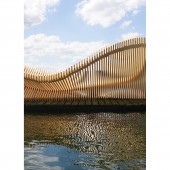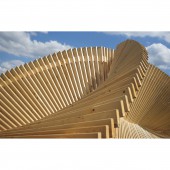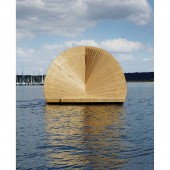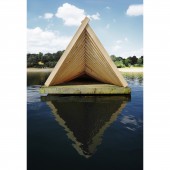Circe Sculptural Pavilion by DaeWha Kang |
Home > Winners > #71563 |
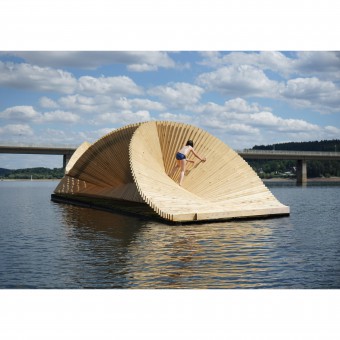 |
|
||||
| DESIGN DETAILS | |||||
| DESIGN NAME: Circe PRIMARY FUNCTION: Sculptural Pavilion INSPIRATION: Circe was the island witch who seduced Odysseus and transformed his sailors into swine. This pavilion tempts visitors with its surprising forms, appearing as a solid disc when straight on and as an ethereal and transparent screenwork from the side. Primary forms of circle and diamond merge and blend into creature-like shapes. Parametric design was central to the realisation of the pavilion, but ultimately the aim was to create a sense of wonder, mystery, and joy. UNIQUE PROPERTIES / PROJECT DESCRIPTION: This floating pavilion is part of the art exhibition ‘odyssee’ on mohnesee lake, Germany. The exhibition featured twenty-four artists who were asked to make pieces on the lake. Named ‘circe’ after the seductive witch from greek mythology, the pavilion provides a resting place for visitors as they swim from artwork to artwork. The theme of transformation takes shape through 278 identical pieces of spruce that turn and shift to create forms that are alternately organic and platonic. OPERATION / FLOW / INTERACTION: The project moves and floats with the motion of the water on the lake. People are invited to climb it, find shade in it, or jump from it into the water. PROJECT DURATION AND LOCATION: The project was exhibited on mohnesee lake, north rhine-westphalia, germany, and is in the process of transforming into a permanent site in the city. FITS BEST INTO CATEGORY: Architecture, Building and Structure Design |
PRODUCTION / REALIZATION TECHNOLOGY: The simple construction method of shifting, rotating, and fixing 8-foot standard spruce 2×4’s meant that the structure could be built by local workers. It was possible to construct in just five days. SPECIFICATIONS / TECHNICAL PROPERTIES: Made from 278 individual pieces of spruce. 40 by 140 by 2400 mm in length. Attached to a floating pontoon. TAGS: wood, pavilion, water, design, architecture, parametric, mystery, joy RESEARCH ABSTRACT: This work uses parametric design to establish a system of form finding and documentation that allows for the construction to take place in a standardised yet unique process. Each individual piece had holes drilled in the exact location required to create the next element of the form. CHALLENGE: The most difficult challenge was to find a system that could be easily understood and handled in a short time frame by carpenters in Germany. Ultimately, the project was built in just a few days. ADDED DATE: 2018-09-29 19:13:57 TEAM MEMBERS (1) : Curator: Vlado Velkov IMAGE CREDITS: DaeWha Kang |
||||
| Visit the following page to learn more: https://www.daewhakang.com | |||||
| CLIENT/STUDIO/BRAND DETAILS | |
 |
NAME: Kunstverein Arnsberg PROFILE: Kunstverein Arnsberg is an art institution in Westphalia, Germany. |
| AWARD DETAILS | |
 |
Circe Sculptural Pavilion by Daewha Kang is Winner in Architecture, Building and Structure Design Category, 2018 - 2019.· Read the interview with designer DaeWha Kang for design Circe here.· Press Members: Login or Register to request an exclusive interview with DaeWha Kang. · Click here to register inorder to view the profile and other works by DaeWha Kang. |
| SOCIAL |
| + Add to Likes / Favorites | Send to My Email | Comment | Testimonials | View Press-Release | Press Kit |
Did you like Daewha Kang's Architecture Design?
You will most likely enjoy other award winning architecture design as well.
Click here to view more Award Winning Architecture Design.


